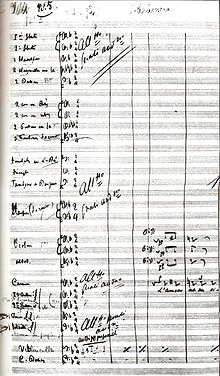Habanera (aria)
Habanera , or L'amour est un oiseau rebelle (English: love is a wild bird ), is the name of a well-known aria from Carmen , an opera by Georges Bizet . The premiere took place on March 3, 1875 in the Opéra-Comique in Paris. The libretto for the opera is by Henri Meilhac and Ludovic Halévy , with the text of the aria written by Georges Bizet himself. The Habanera arie is based on El Arreglito by Sebastián de Yradier and is also very popular outside the world of opera. The aria is sung in the first act by the title character, the gypsy Carmen ( mezzo-soprano ), in it she expresses her indifference to the declarations of love and advances made by her numerous admirers.
Musical structure
Carmen's Habanera is written for a mezzo-soprano part. The first 19 or 16 bars with the distinctive chromatically descending melody line of the two stanzas sound in D minor , the following in D major . The time signature is a slow 2 ⁄ 4 . Bizet specifies the tempo designation Allegretto quasi Andantino and as the value for the metronome ![]() = 72. The quarter note should therefore be played at 72 beats per minute. With its 120 bars, the aria therefore lasts between three and a half and four and a half minutes, depending on the interpretation. The musical tone strength begins with an extremely soft (pianissimo) and increases at the end to a triumphant (fortissimo) in the final chord.
= 72. The quarter note should therefore be played at 72 beats per minute. With its 120 bars, the aria therefore lasts between three and a half and four and a half minutes, depending on the interpretation. The musical tone strength begins with an extremely soft (pianissimo) and increases at the end to a triumphant (fortissimo) in the final chord.
![]()
![]()
Text (excerpt)
French:
L'amour est un oiseau rebelle
que nul ne peut apprivoiser,
et c'est bien en vain qu'on l'appelle,
s'il lui convient de refuser.
Rien n'y fait, menace ou prière,
l'un parle bien, l'autre se tait:
Et c'est l'autre que je préfère,
Il n'a rien dit mais il me plaît.
L'amour! L'amour! L'amour! L'amour!
German
Love is a wild bird
that no one can ever tame,
you will call it for nothing,
it always breaks free from your spell.
No flattery helps and no anger,
one speaks, the other is silent:
it is the other I prefer,
he said nothing, but I like him.
Love! Love! Love! Love!
Edits
Georges Bizet also used the Habanera melody in concert performance in his second Carmen Suite for orchestra. In addition, the piece has been adapted, edited and transcribed by many artists , including Friedrich Hollaender , who used the Habanera melody for Berlin cabaret artist Annemarie Hase in his 1931 satirical couplet The Jews are to blame for everything .
Web links
- L'amour est un oiseau rebelle , Habanera in the Aria database
- Habanera recording (Youtube) , Metropolitan Opera, New York
Individual evidence
- ↑ Deutschlandfunk , Kalenderblatt (Deutschlandfunk dedicated this broadcast to Ludovic Halévy on the centenary of his death), Ruth Fühner: "The matter is of little importance for Meilhac [meaning Henri Meilhac (librettist)] and me," he wrote [meaning Ludovic Halévy (Librettist)] shortly before the world premiere of Georges Bizet's opera Carmen in 1875. He was irritated by the new dramatic gesture that his cousin's husband brought to the opera stage. Also too busy with other pieces to really help Bizet, who kept asking for changes; so that the famous habanera is also the text of the composer, not that of the librettist.
- ↑ further information on Carmen , Opera Guide
- ↑ Sheet music from the music publisher Choudens Père et Fils , Paris 1875 (PDF; 638 kB)

